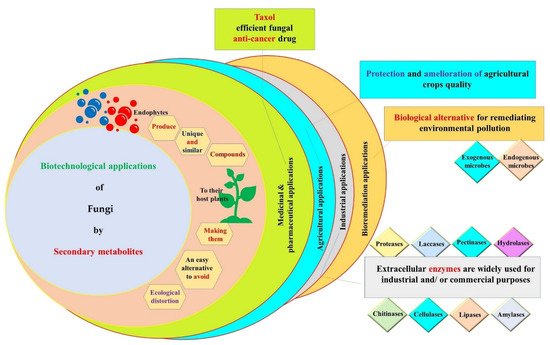Extracellular enzymes are the most common and searched compounds extracted from endophytic fungi for industrial and/or commercial purposes
[28][9]. They include chitinases, cellulases, amylases, xylanases, pectinases, hydrolases, laccases, proteases, lipases, etc.
[58][59][91,92]. Enzymes are used to degrade complex compounds into small ones that are easy to degrade or assimilate
[60][93]. Various types of industries prefer using microbial hydrolytic enzymes due to their high stability, broad availability, cost-effectiveness and eco-friendliness
[61][62][94,95]. For instance, protease dominates the global enzymes market and is responsible for hydrolyzing proteins and their derivatives into simple constituents (amino acids and oligopeptides). Fungal proteases are preferred for their high stability
[59][92], and thus they are mostly used in pharmaceutical, therapeutic
[63][64][26,96], food
[65][97], detergent
[66][98], waste management
[67][99], leather and textile
[68][100] industries. The cellulolytic enzyme is used to degrade cellulose and its related polysaccharides. It is applied in the human food, animal feed, agriculture, paper, laundry, wine and textile industries
[69][101]. Xylanase works in synergy with esterase to hydrolyze xylan, which is a plant polysaccharide. Such organic carbon is mainly utilized in food-related industries (baking, drinking, etc.)
[70][71][102,103]. In addition, it has been extensively documented that bacteria and fungi appear to be the dominant chitin decomposers due to the production of highly active and thermostable chitinase enzymes
[72][104]. The application of chitinase is concentrated in seafood industries, since the catalyzation of chitin increases the nutritional benefits of seafood
[73][74][105,106], human health improvements, due to its antioxidant, anti-inflammatory, antimicrobial and antitumor properties
[75][76][107,108], and the biocontrol of phytopathogenic fungi and pests
[77][109]. In addition, fungal pectinase is used to hydrolyze plant pectin. This enzyme is widely known in multiple industries for its versatile applications in fruit juice processing
[78][110], breaking down pectin from agronomic and industrial wastes
[79][111], textile industries
[80][112], paper recycling
[81][113] and many other applications
[82][114]. Lipase is a serine hydrolase responsible for breaking down fats and oils; thus, it is essential in the food industry
[83][115]. Lipases extracted from fungi are able to withstand extreme conditions
[84][116]. Phytase enzyme is used to degrade phytates. It is especially used in the environmental, nutritional, and biotechnological fields
[85][86][117,118]. Last but not least, amylase is responsible for converting starch into different types of sugars, and amylases originating from fungi are known to be thermostable: this is a redeeming feature for starch-producing industries
[87][119].

